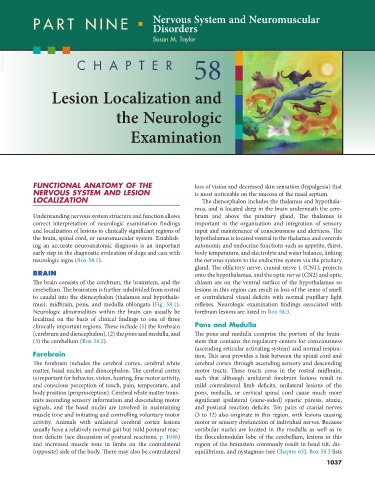Page 1065 - Small Animal Internal Medicine, 6th Edition
P. 1065
PART NINE Nervous System and Neuromuscular
Disorders
Susan M. Taylor
VetBooks.ir CHAPTER 58
Lesion Localization and
the Neurologic
Examination
FUNCTIONAL ANATOMY OF THE loss of vision and decreased skin sensation (hypalgesia) that
NERVOUS SYSTEM AND LESION is most noticeable on the mucosa of the nasal septum.
LOCALIZATION The diencephalon includes the thalamus and hypothala-
mus, and is located deep in the brain underneath the cere-
Understanding nervous system structure and function allows brum and above the pituitary gland, The thalamus is
correct interpretation of neurologic examination findings important in the organization and integration of sensory
and localization of lesions to clinically significant regions of input and maintenance of consciousness and alertness. The
the brain, spinal cord, or neuromuscular system. Establish- hypothalamus is located ventral to the thalamus and controls
ing an accurate neuroanatomic diagnosis is an important autonomic and endocrine functions such as appetite, thirst,
early step in the diagnostic evaluation of dogs and cats with body temperature, and electrolyte and water balance, linking
neurologic signs (Box 58.1). the nervous system to the endocrine system via the pituitary
gland. The olfactory nerve, cranial nerve 1 (CN1), projects
BRAIN onto the hypothalamus, and the optic nerve (CN2) and optic
The brain consists of the cerebrum, the brainstem, and the chiasm are on the ventral surface of the hypothalamus so
cerebellum. The brainstem is further subdivided from rostral lesions in this region can result in loss of the sense of smell
to caudal into the diencephalon (thalamus and hypothala- or contralateral visual deficits with normal pupillary light
mus), midbrain, pons, and medulla oblongata (Fig. 58.1). reflexes. Neurologic examination findings associated with
Neurologic abnormalities within the brain can usually be forebrain lesions are listed in Box 58.3.
localized on the basis of clinical findings to one of three
clinically important regions. These include (1) the forebrain Pons and Medulla
(cerebrum and diencephalon), (2) the pons and medulla, and The pons and medulla comprise the portion of the brain-
(3) the cerebellum (Box 58.2). stem that contains the regulatory centers for consciousness
(ascending reticular activating system) and normal respira-
Forebrain tion. This area provides a link between the spinal cord and
The forebrain includes the cerebral cortex, cerebral white cerebral cortex through ascending sensory and descending
matter, basal nuclei, and diencephalon. The cerebral cortex motor tracts. These tracts cross in the rostral midbrain,
is important for behavior, vision, hearing, fine motor activity, such that although unilateral forebrain lesions result in
and conscious perception of touch, pain, temperature, and mild contralateral limb deficits, unilateral lesions of the
body position (proprioception). Cerebral white matter trans- pons, medulla, or cervical spinal cord cause much more
mits ascending sensory information and descending motor significant ipsilateral (same-sided) spastic paresis, ataxia,
signals, and the basal nuclei are involved in maintaining and postural reaction deficits. Ten pairs of cranial nerves
muscle tone and initiating and controlling voluntary motor (3 to 12) also originate in this region, with lesions causing
activity. Animals with unilateral cerebral cortex lesions motor or sensory dysfunction of individual nerves. Because
usually have a relatively normal gait but mild postural reac- vestibular nuclei are located in the medulla as well as in
tion deficits (see discussion of postural reactions, p. 1046) the flocculonodular lobe of the cerebellum, lesions in this
and increased muscle tone in limbs on the contralateral region of the brainstem commonly result in head tilt, dis-
(opposite) side of the body. There may also be contralateral equilibrium, and nystagmus (see Chapter 63). Box 58.3 lists
1037

